Assessment of the Sensitivity of Daily Maximum and Minimum Air Temperatures of Egypt to Soil Moisture Status and Land Surface Parameterization Using RegCM4 †
Abstract
:1. Introduction
- Study the role of land surface parameterization (BATS versus CLM45) in simulating the daily TMX and TMN of Egypt with respect to the Climate Research Unit (CRU [15]) considering the ESACCI as an initial condition of the soil moisture.
- Evaluate the climatological annual cycle of the TMX and TMN with respect to the station observations.
2. Materials and Methods
2.1. Model Description and Experiment Design
2.2. Observational Data
- Climate Research Unit (CRU [15]): It was used to evaluate the simulated TMX and TMN on a regional scale over the period of 2001–2010. Basically, CRU is based on upscaling of the meteorological observations across the globe and then interpolates the meteorological variables over the land units on a grid of 0.5 × 0.5 degrees grid spacing. CRU was considered in the present study because it is available over a long period starting from 1901 to 2022. Additionally, CRU has no missed values over the selected domain. For the purpose of the present study, CRU was bilinearly interpolated on the RegCM4 curvilinear grid based on [21]. In this study, the last version (4.07) of the CRU was used.
- Station observation (OBS): The monthly average of the TMX and TMN were collected for fifteen stations, representing different climate zones of Egypt over the period of 2001–2010. Table 1 shows the station coordinates, world meteorological organization (WMO) ID and elevation above mean sea level (in meters). It should be noted that the climatology (of each month) was calculated to produce the climatological annual cycle of the TMX/TMN (to evaluate the RegCM4 performance at each location).
3. Results
3.1. Soil Moisture Initialization
3.2. Land Surface Parameterization
3.2.1. Diagnostic Analysis
3.2.2. The Influence on Maximum/Minimum Air Temperature (TMX/TMN)
3.3. Climatological Annual Cycle
3.3.1. Maximum Air Temperature (TMX)
3.3.2. Minimum Air Temperature (TMN)
4. Discussion and Conclusions
Supplementary Materials
Author Contributions
Funding
Institutional Review Board Statement
Informed Consent Statement
Data Availability Statement
Acknowledgments
Conflicts of Interest
References
- Fisher, B.J.; Huntzinger, N.D.; Schwalm, C.R.; Sitch, S. Modelling the terrestrial biosphere. Ann. Rev. Environ. Resour. 2014, 39, 91–123. [Google Scholar] [CrossRef]
- Stuart, F.C., III; Matson, P.A.; Mooney, H.A. Principles of Terrestrial Ecosystem Ecology; Spinger: New York, NY, USA, 2002; pp. 4–211. [Google Scholar]
- Anwar, S.A.; Zakey, A.; Robaa, S.; Wahab, M.M.A. The influence of two land-surface hydrology schemes on the regional climate of Africa using the RegCM4 model. Theor. Appl. Clim. 2019, 136, 1535–1548. [Google Scholar] [CrossRef]
- Giorgi, F.; Coppola, E.; Solmon, F.; Mariotti, L.; Sylla, M.B.; Bi, X.; Elguindi, N.; Diro, G.T.; Nair, V.; Giuliani, G.; et al. RegCM4: Model description and preliminary tests over multiple CORDEX domains. Clim. Res. 2012, 52, 7–29. [Google Scholar] [CrossRef]
- Oleson, K.W.; Lawrence, D.M.; Bonan, G.B.; Drewniak, B.; Huang, M.; Koven, C.D.; Levis, S.; Li, F.; Riley, W.J.; Subin, Z.M.; et al. Technical Description of Version 4.5 of the Community Land Model (CLM); NCAR Technical Note NCAR/TN-503þ STR; National Center for Atmospheric Research: Boulder, CO, USA, 2013. [Google Scholar]
- Anwar, S.A.; Srivastava, A.; Zerouali, B. On the role of land-surface hydrology schemes in simulating the daily maximum and minimum air temperatures of Australia using a regional climate model (RegCM4). J. Water Clim. Chang. 2023, 14, 989–1011. [Google Scholar] [CrossRef]
- Steiner, A.L.; Pal, J.S.; Rauscher, S.A.; Bell, J.L.; Diffenbaugh, N.S.; Boone, A.; Sloan, L.C.; Giorgi, F. Land surface coupling in regional climate simulations of the West African monsoon. Clim. Dyn. 2009, 33, 869–892. [Google Scholar] [CrossRef]
- Oleson, K.W.; Niu, G.; Yang, Z.; Lawrence, D.M.; Thornton, P.E.; Lawrence, P.J.; Stöckli, R.; Dickinson, R.E.; Bonan, G.B.; Levis, S.; et al. Improvements to the Community Land Model and their impact on the hydrological cycle. J. Geophys. Res. 2008, 113, G01021. [Google Scholar] [CrossRef]
- Dickinson, R.E.; Henderson-Sellers, A.; Kennedy, P.J. Biosphere-Atmosphere Transfer Scheme (BATS) Version 1e as Coupled to the NCAR Community Climate Model (No. NCAR/TN-387þ STR; University Corporation for Atmospheric Research: Boulder, CO, USA, 1993. [Google Scholar] [CrossRef]
- Maurya, R.K.S.; Sinha, P.; Mohanty, M.R.; Mohanty, U.C. Coupling of Community Land Model with RegCM4 for Indian Summer Monsoon Simulation. Pure Appl. Geophys. 2017, 174, 4251–4270. [Google Scholar] [CrossRef]
- Chung, J.X.; Juneng, L.; Tangang, F.; Jamaluddin, A.F. Performances of BATS and CLM land-surface schemes in RegCM4 in simulating precipitation over CORDEX Southeast Asia domain. Int. J. Clim. 2018, 38, 794–810. [Google Scholar] [CrossRef]
- Constantinidou, K.; Hadjinicolaou, P.; Zittis, G.; Lelieveld, J. Sensitivity of simulated climate over the MENA region related to different land surface schemes in the WRF model. Theor. Appl. Clim. 2020, 141, 1431–1449. [Google Scholar] [CrossRef]
- Dorigo, W.; Wagner, W.; Albergel, C.; Albrecht, F.; Balsamo, G.; Brocca, L.; Chung, D.; Ertl, M.; Forkel, M.; Gruber, A.; et al. ESA CCI Soil Moisture for improved Earth system understanding: State-of-the art and future directions. Remote Sens. Environ. 2017, 203, 185–215. [Google Scholar] [CrossRef]
- Gruber, A.; Scanlon, T.; van der Schalie, R.; Wagner, W.; Dorigo, W. Evolution of the ESA CCI Soil Moisture climate data records and their underlying merging methodology. Earth Syst. Sci. Data 2019, 11, 717–739. [Google Scholar] [CrossRef]
- Harris, I.; Osborn, T.J.; Jones, P.; Lister, D. Version 4 of the CRU TS monthly high-resolution gridded multivariate climate dataset. Sci. Data 2020, 7, 109. [Google Scholar] [CrossRef] [PubMed]
- Pal, J.S.; Giorgi, F.; Bi, X.; Elguindi, N.; Solmon, F.; Gao, X.; Rauscher, S.A.; Francisco, R.; Zakey, A.; Winter, J.; et al. Regional Climate Modeling for the Developing World: The ICTP RegCM3 and RegCNET. Bull. Am. Meteorol. Soc. 2007, 88, 1395–1410. [Google Scholar] [CrossRef]
- Grell, G.A.; Dudhia, J.; Stauffer, D.R. Description of the Fifth Generation Penn State/NCAR Mesoscale Model (MM5); NCAR Technical Note NCAR/TN-398+STR; Technical Note; National Center for Atmospheric Research (NCAR): Boulder, CO, USA, 1994; p. 121. [Google Scholar] [CrossRef]
- Giorgi, F.; Coppola, E.; Giuliani, G.; Ciarlo`, J.M.; Pichelli, E.; Nogherotto, R.; Raffaele, F.; Malguzzi, P.; Davolio, S.; Stocchi, P.; et al. The Fifth Generation Regional Climate Modeling System, RegCM5: Description and Illustrative Examples at Parameterized Convection and Convection-Permitting Resolutions. J. Geophys. Res. Atmos. 2023, 128, e2022JD038199. [Google Scholar] [CrossRef]
- Anwar, S.A.; Diallo, I. Modelling the Tropical African Climate using a state-of-the-art coupled regional climate-vegetation model. Clim. Dyn. 2022, 58, 97–113. [Google Scholar] [CrossRef]
- Kanamitsu, M.; Ebisuzaki, W.; Woollen, J.; Yang, S.K.; Hnilo, J.J.; Fiorino, M.; Potter, G.L. NCEP-DOE AMIP-II Reanalysis (R-2). Bull. Am. Meteorol. Soc. 2002, 83, 1631–1643. [Google Scholar] [CrossRef]
- Anwar, S.A.; Lazić, I. Estimating the Potential Evapotranspiration of Egypt Using a Regional Climate Model and a High-Resolution Reanalysis Dataset. Environ. Sci. Proc. 2023, 25, 29. [Google Scholar] [CrossRef]
- Frey, C.M.; Parlow, E.; Vogt, R.; Harhash, M.; Wahab, M.M.A. Flux measurements in Cairo. Part 1: In situ measurements and their applicability for comparison with satellite data. Int. J. Clim. 2011, 31, 218–231. [Google Scholar] [CrossRef]
- Mekawy, M.; Saber, M.; Mekhaimar, S.A.; Zakey, A.S.; Robaa, S.M.; Wahab, M.A. Evaluation of WRF Microphysics Schemes Performance Forced by Reanalysis and Satellite-Based Precipitation Datasets for Early Warning System of Extreme Storms in Hyper Arid Environment. Climate 2023, 11, 8. [Google Scholar] [CrossRef]
- Steiner, A.; Tawfik, A.; Shalaby, A.; Zakey, A.; Abdel-Wahab, M.; Salah, Z.; Solmon, F.; Sillman, S.; Zaveri, R. Climatological simulations of ozone and atmospheric aerosols in the Greater Cairo region. Clim. Res. 2014, 59, 207–228. [Google Scholar] [CrossRef]
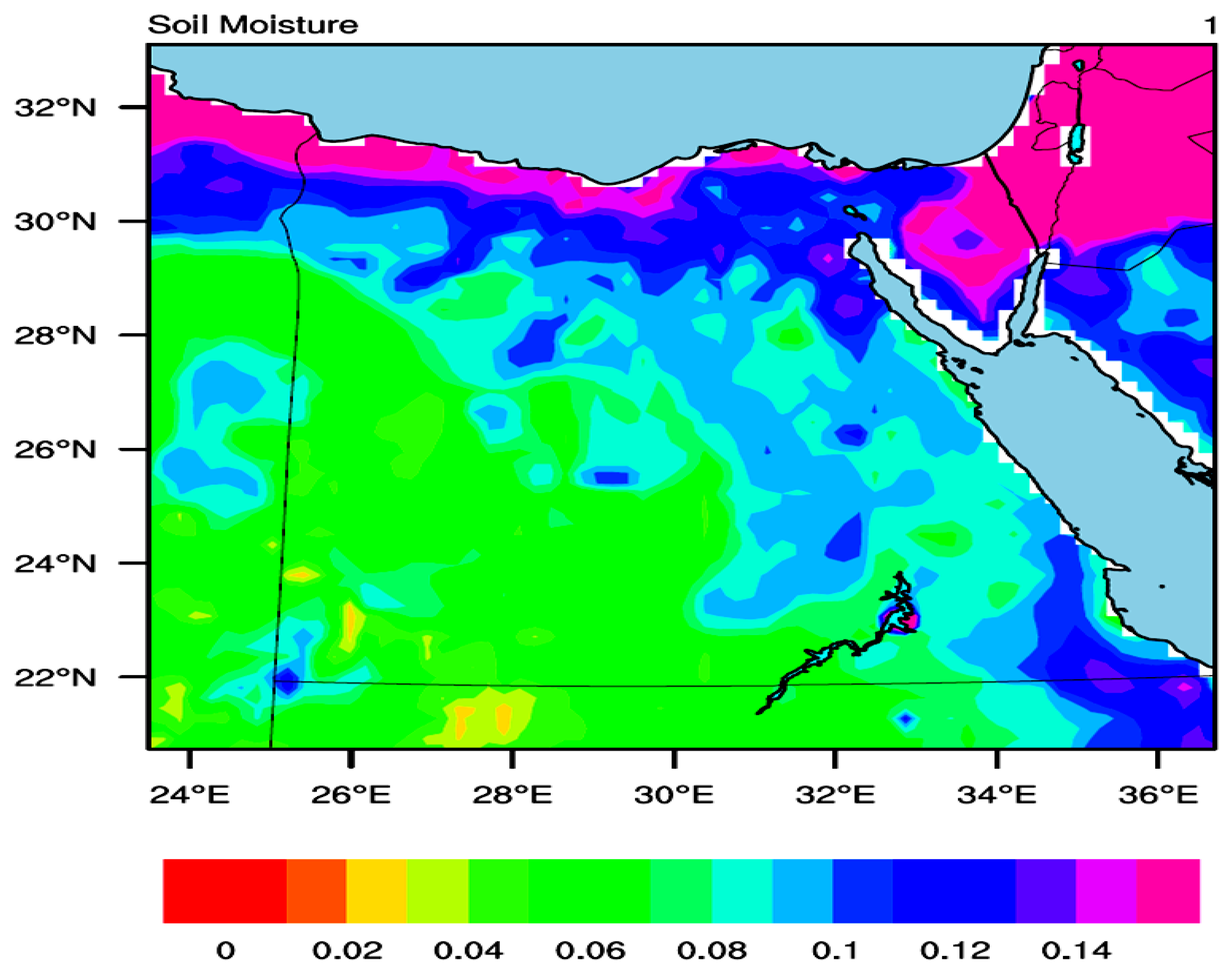
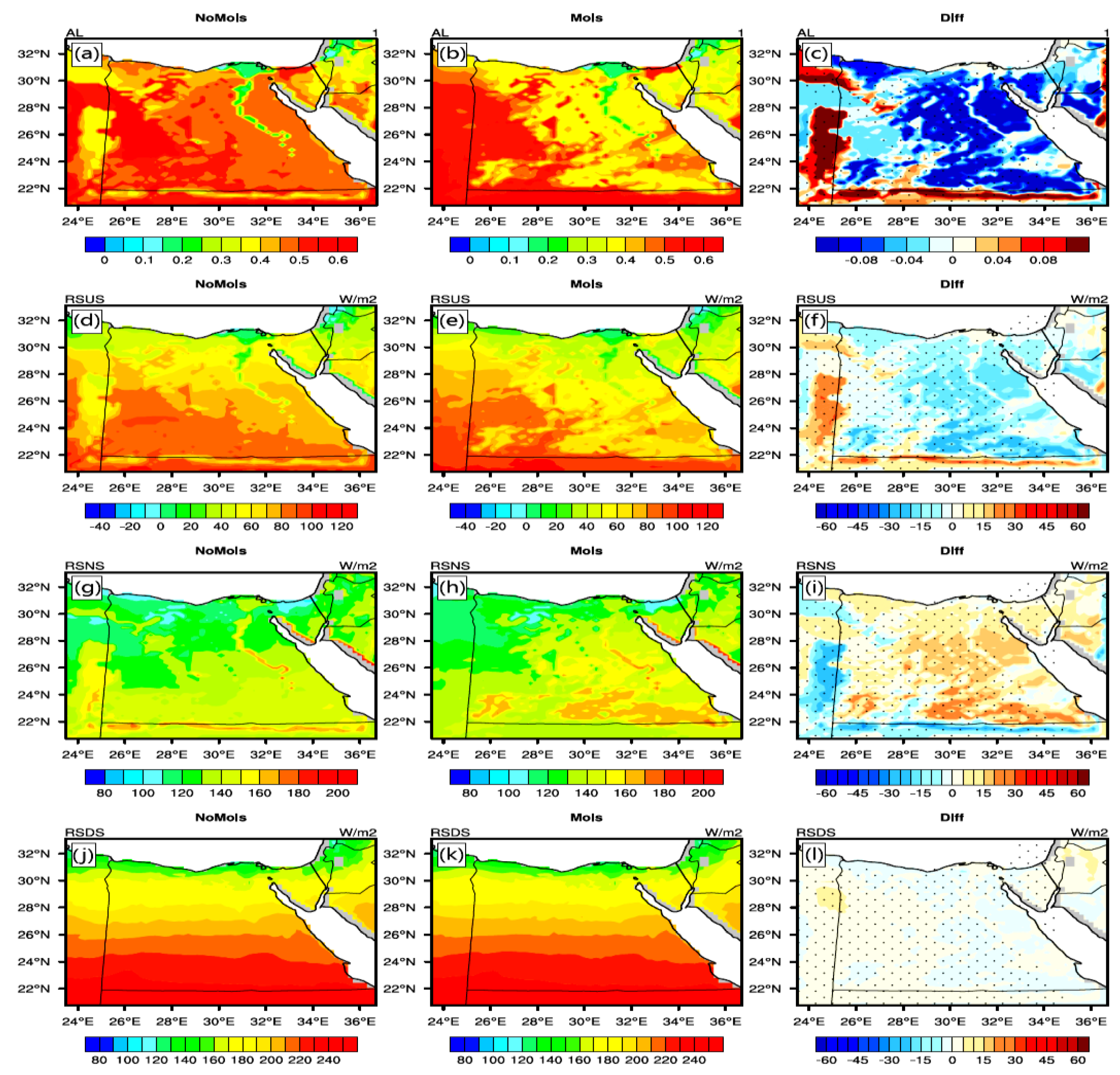
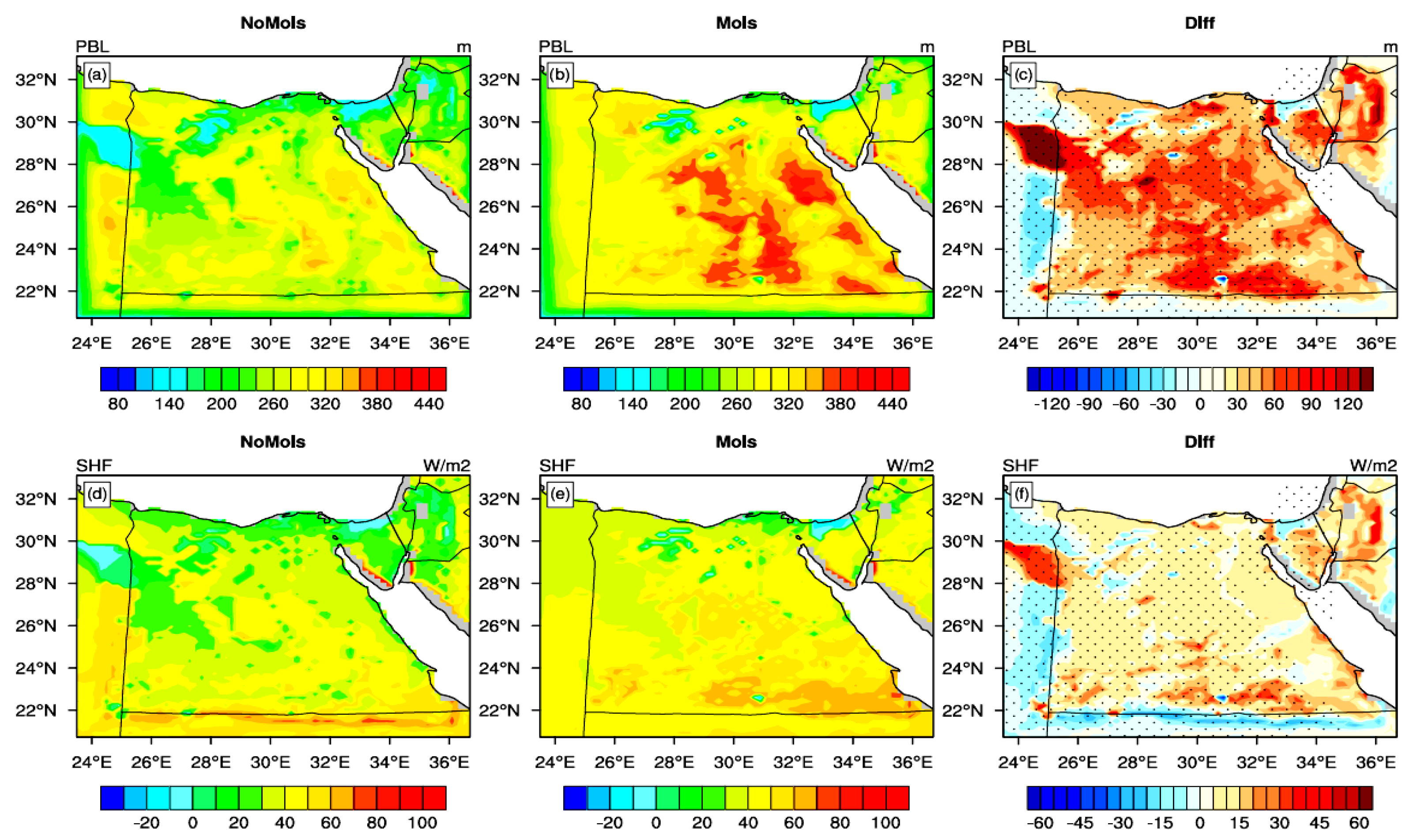
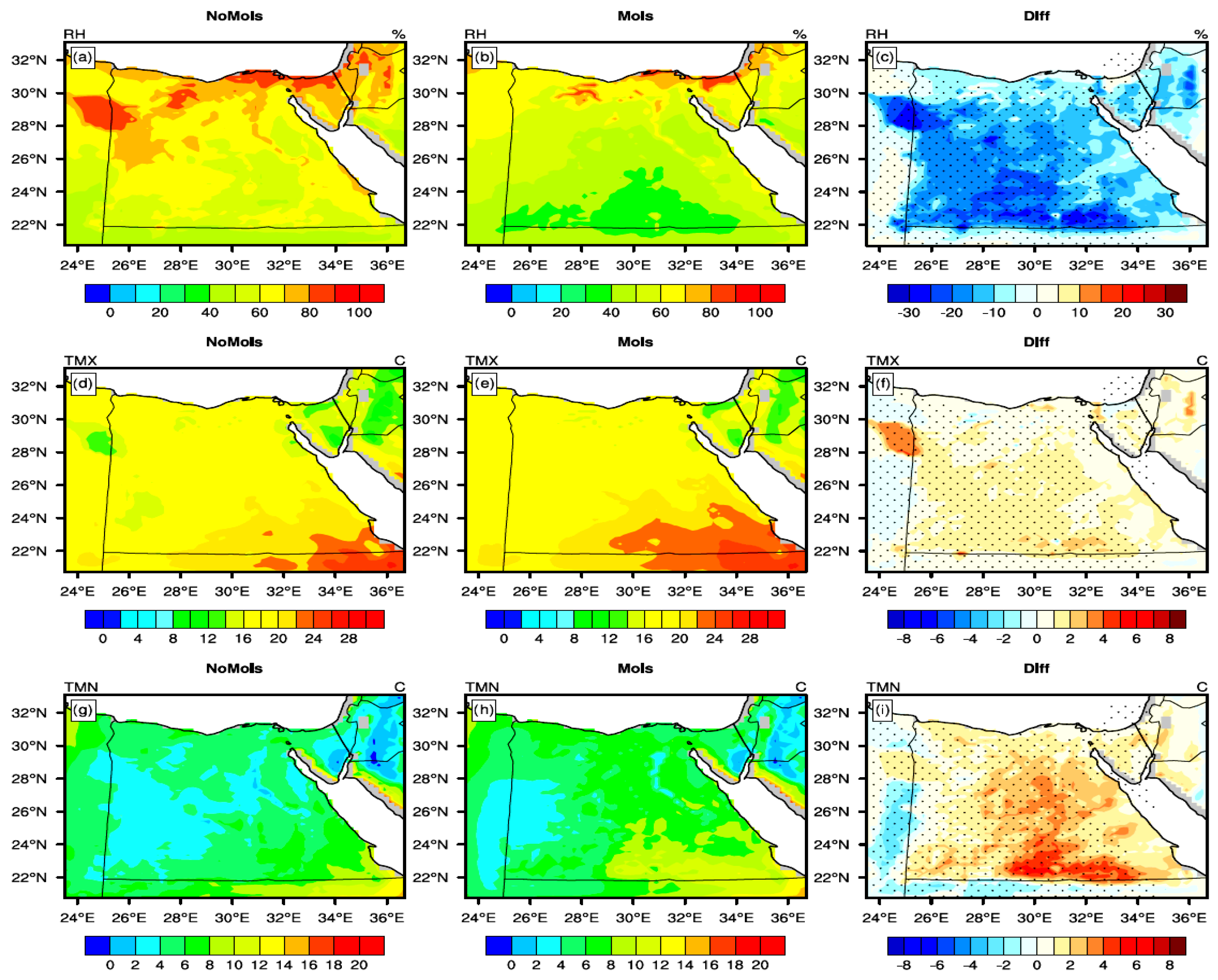
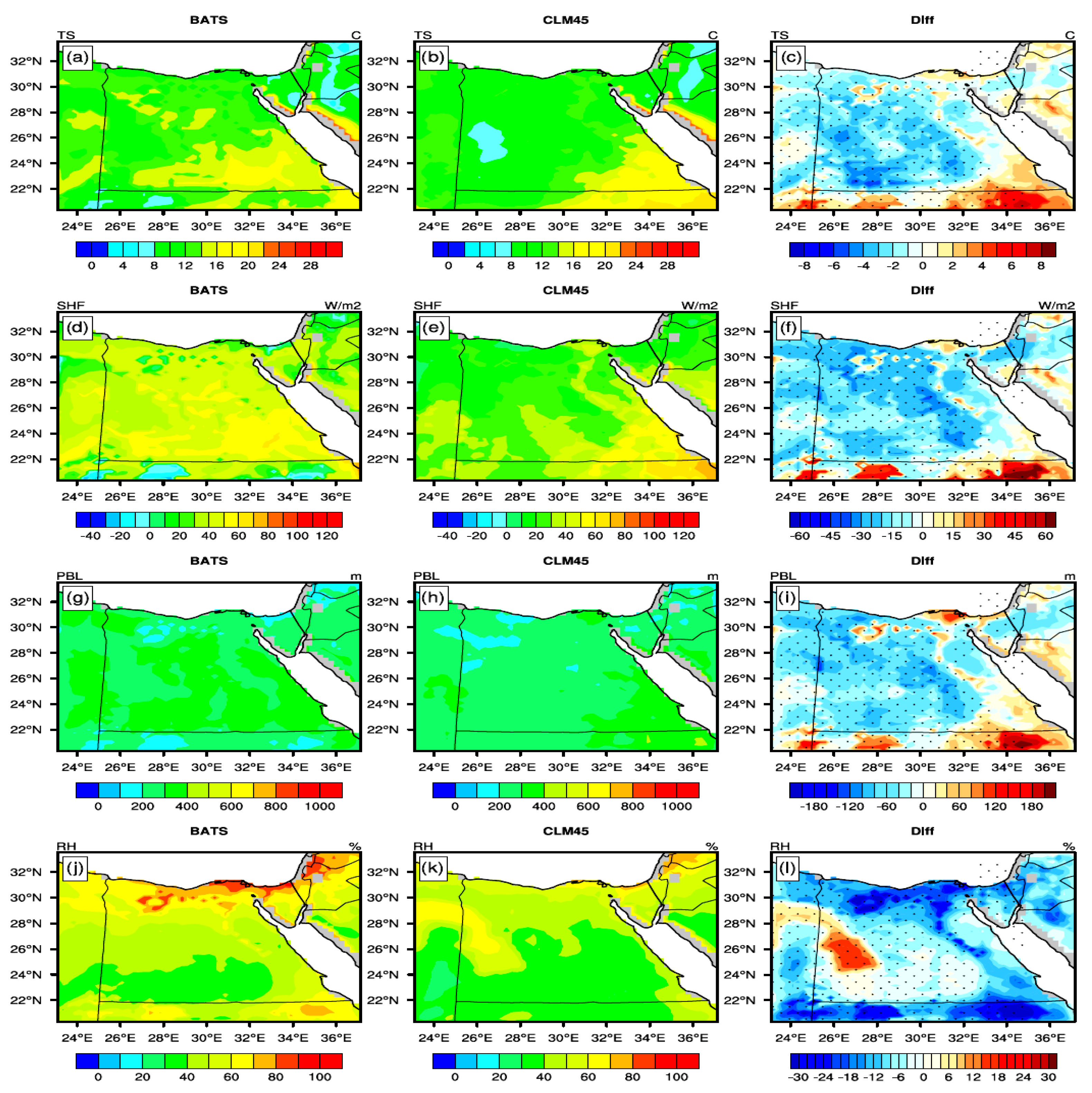
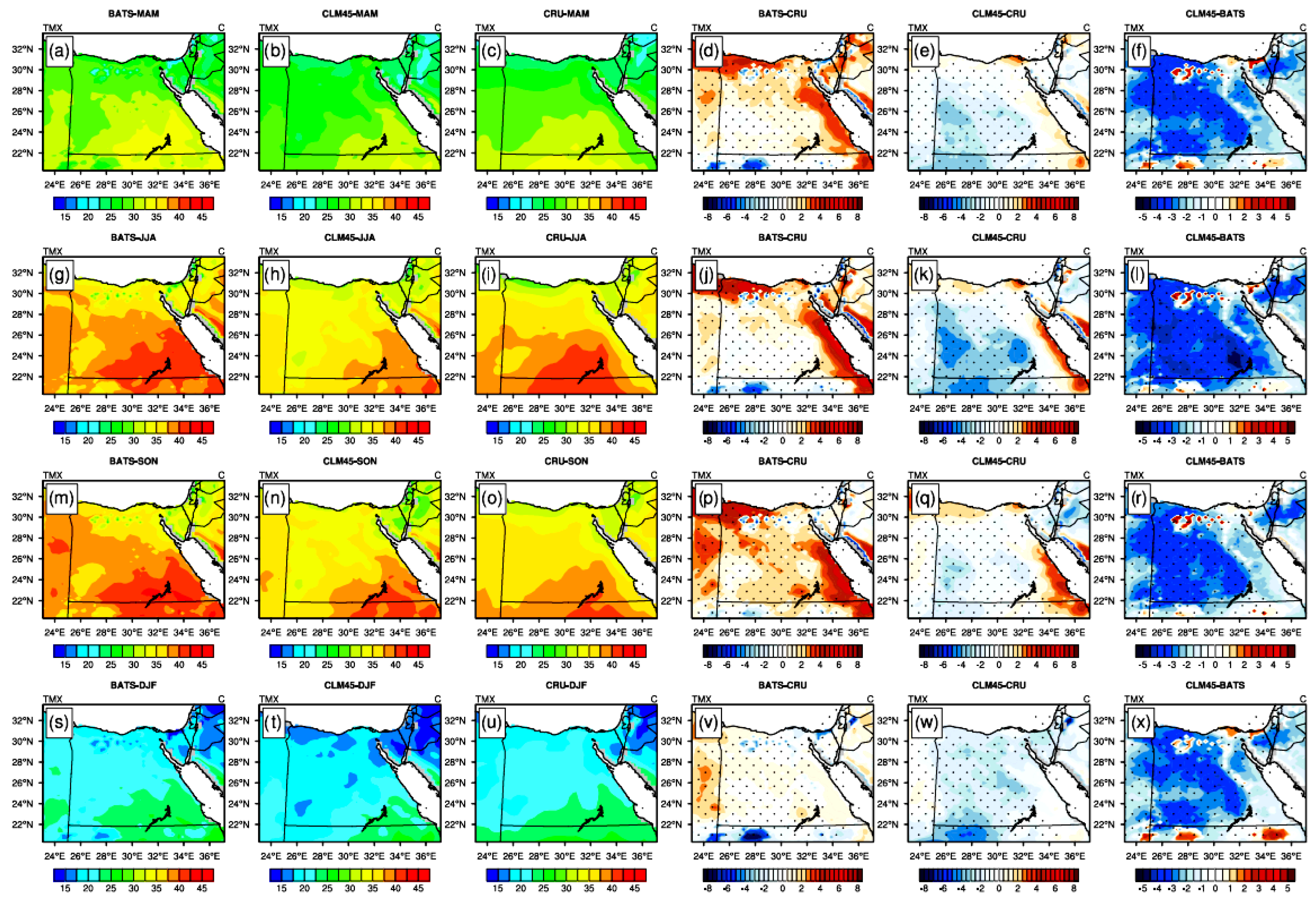
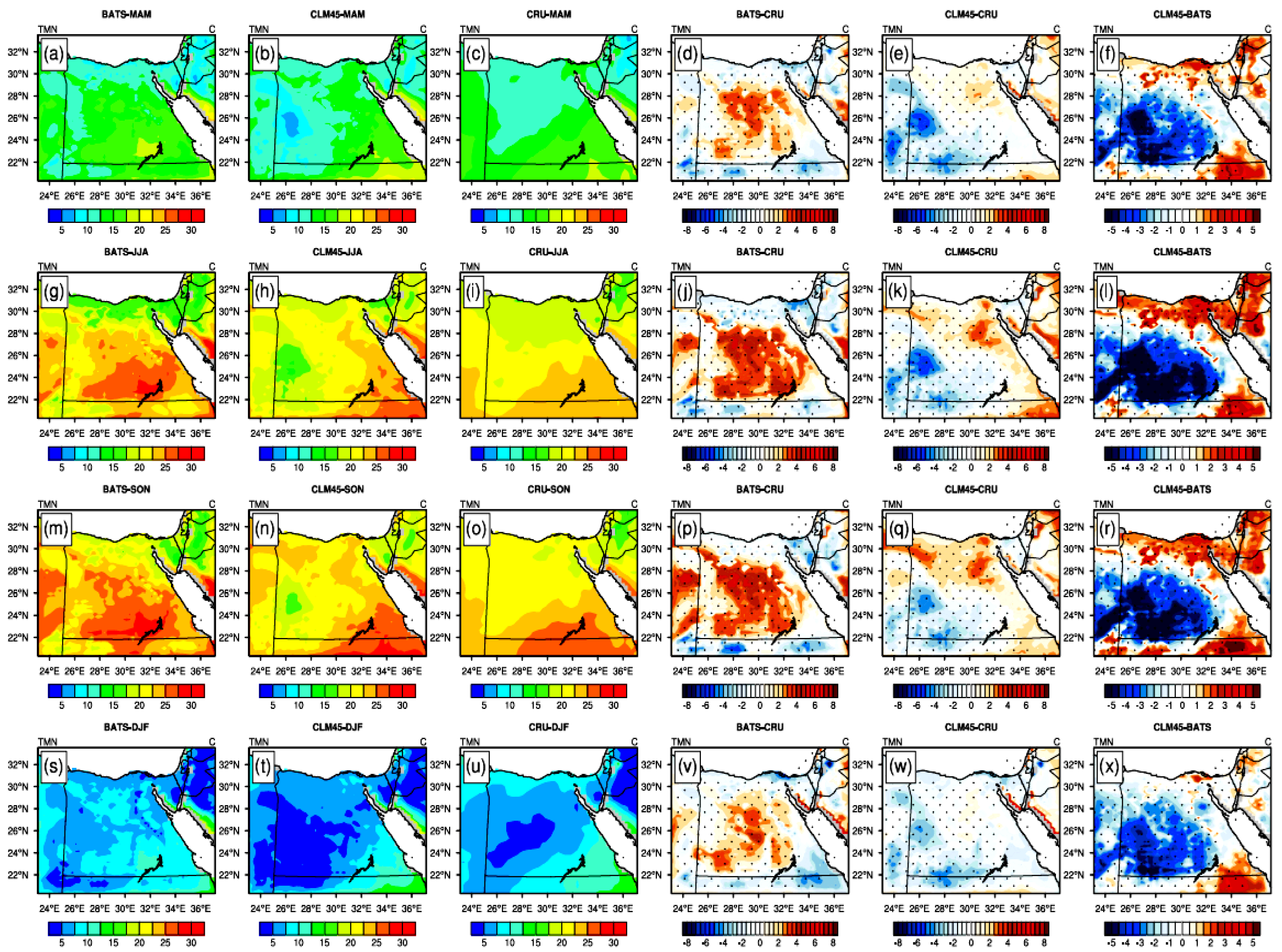

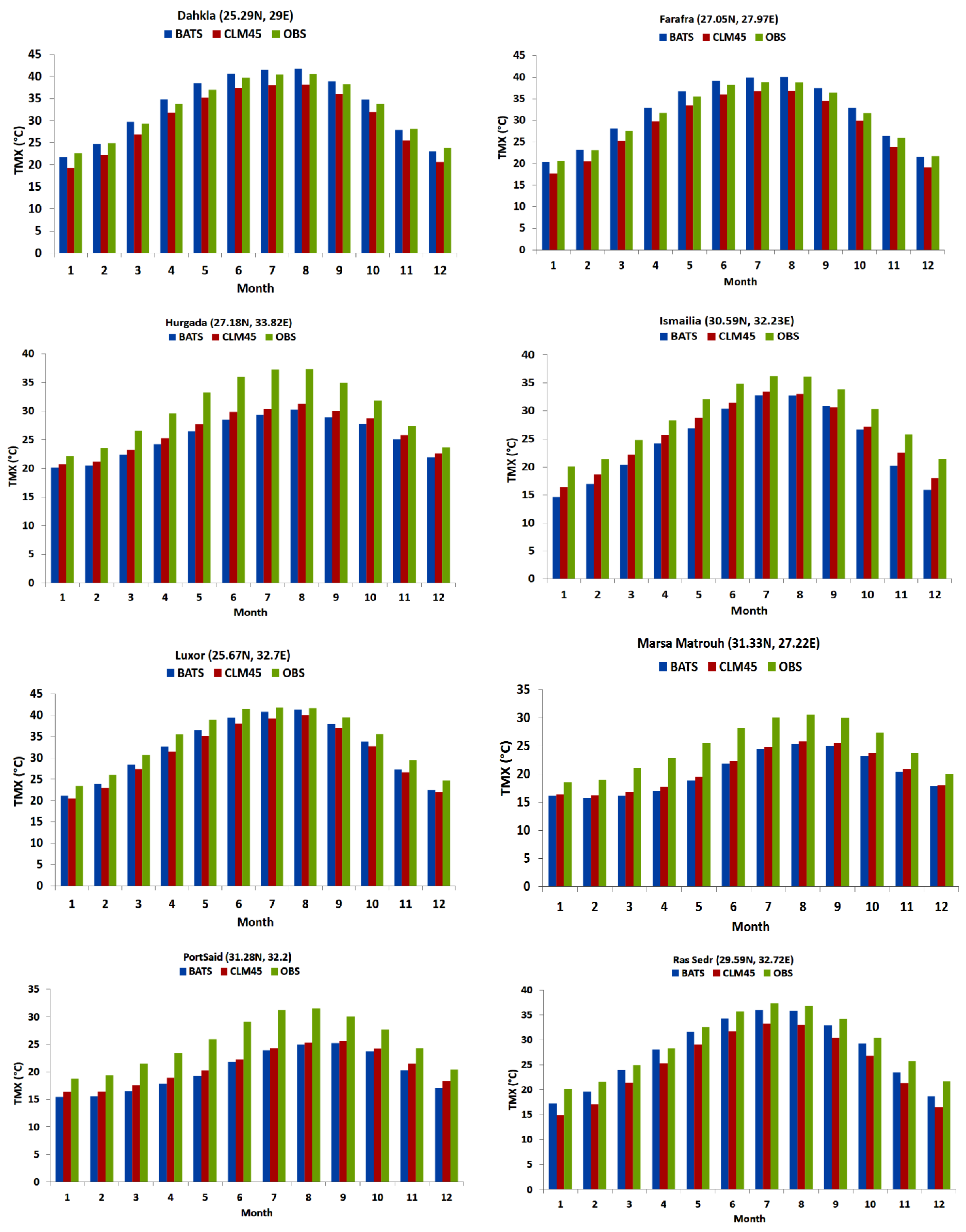
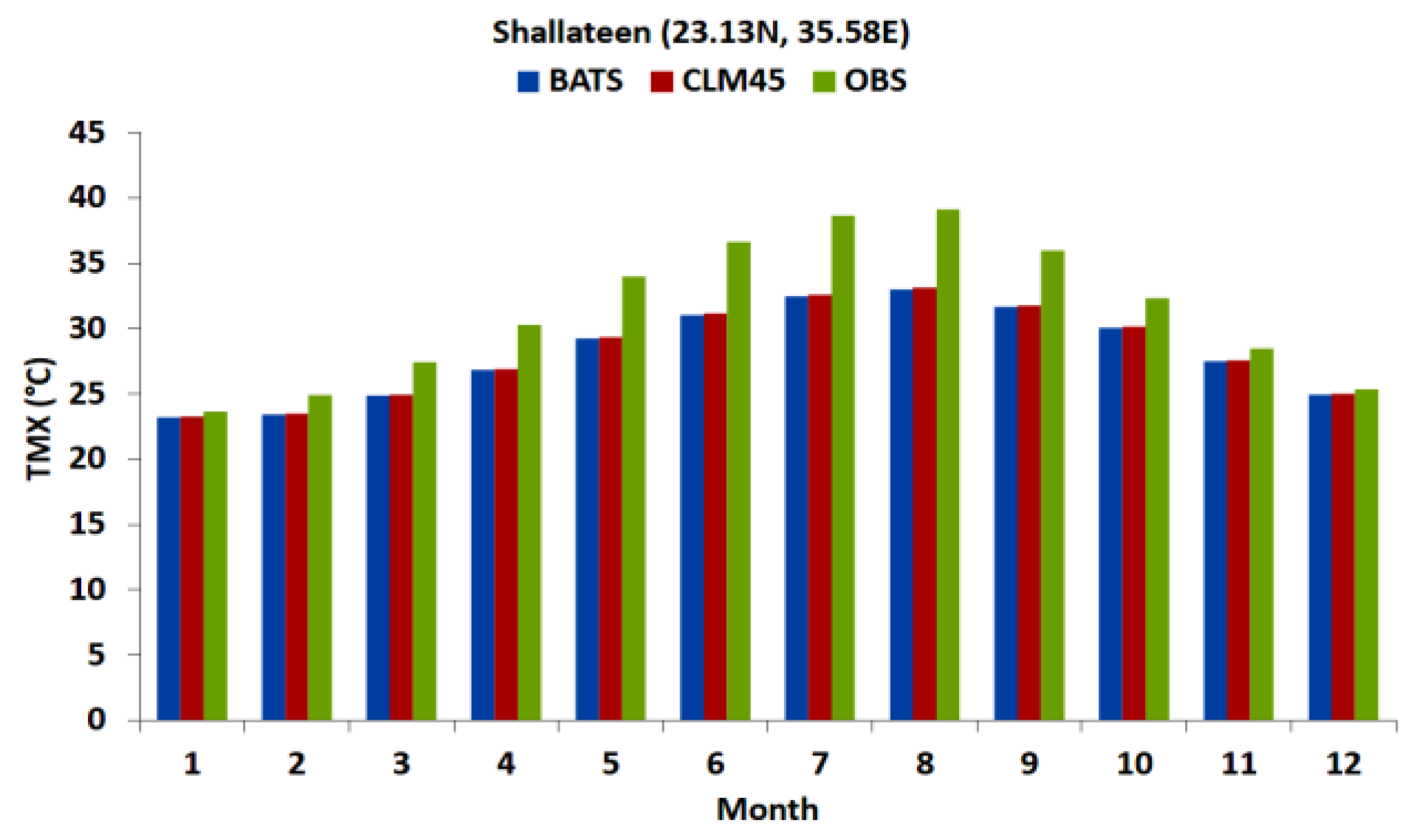
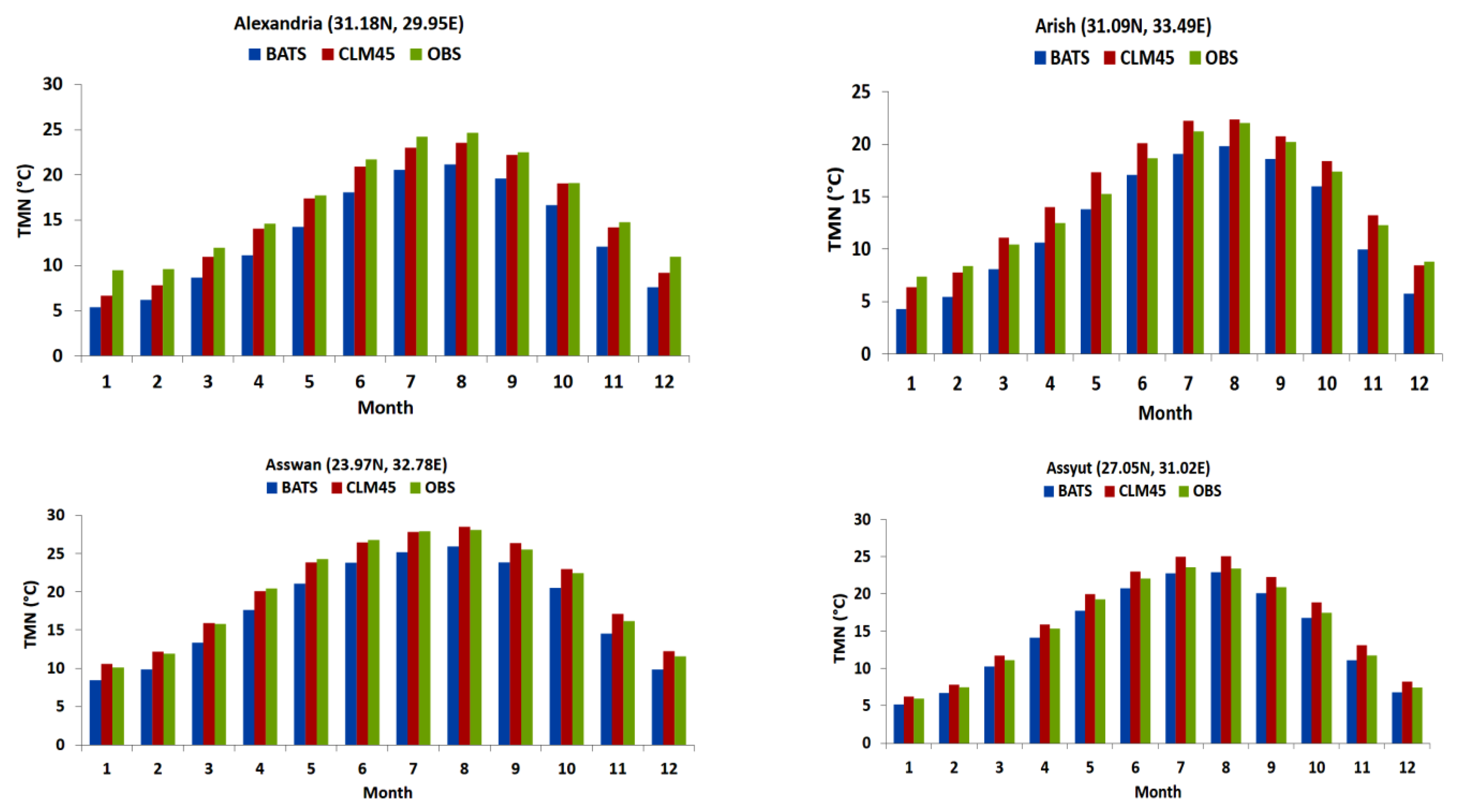
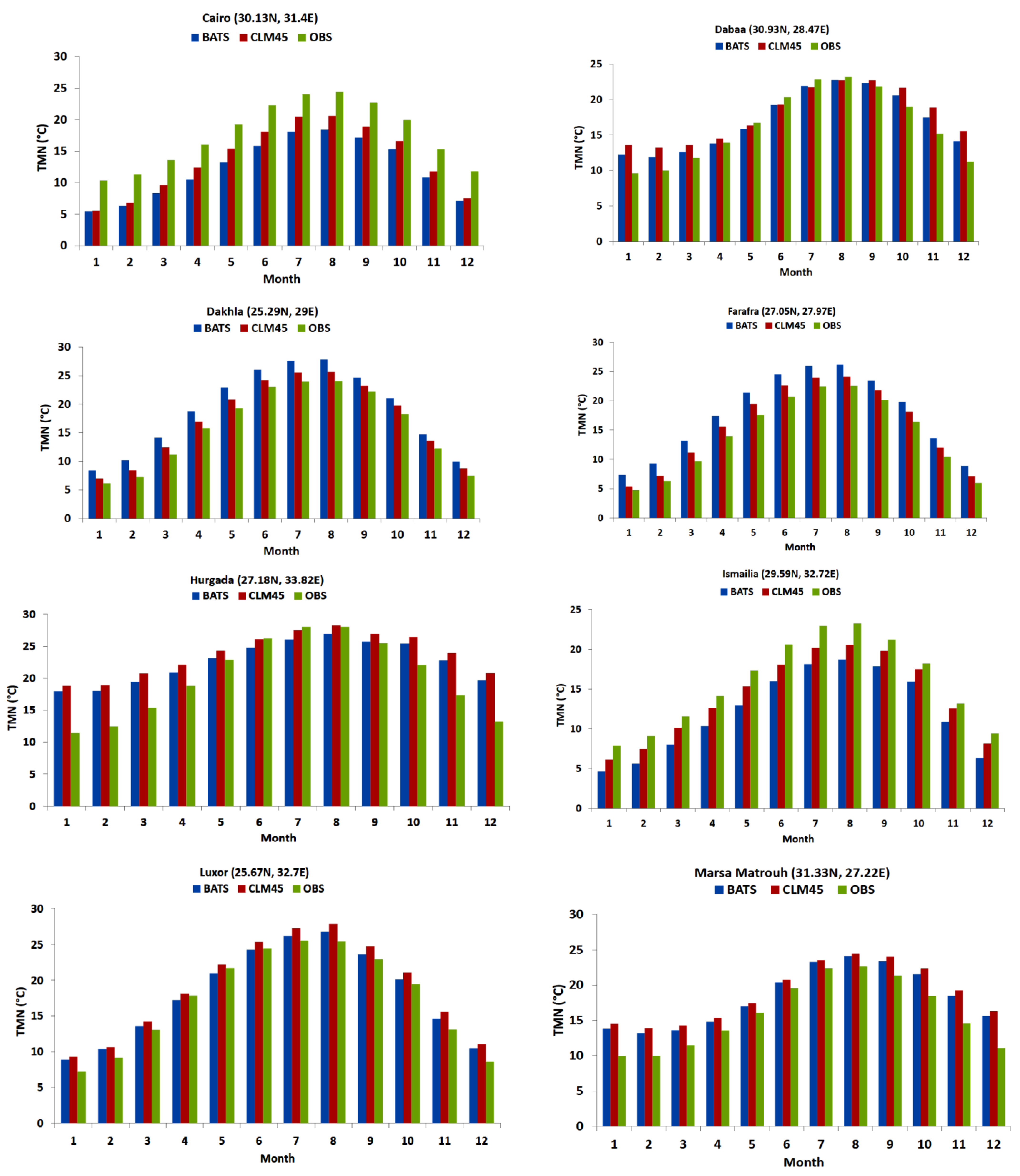

| Station | WMO Code | Longitude (°E) | Latitude (°N) | Elevation (m) |
|---|---|---|---|---|
| Marsa-Matrouh | 62306 | 27.22 | 31.33 | 25 |
| Dabaa | 62309 | 28.47 | 30.93 | 17 |
| Alexandria | 62318 | 29.95 | 31.18 | −2.626 |
| Port Said | 62332 | 32.20 | 31.28 | 0.8 |
| Arish | 62337 | 33.49 | 31.09 | 30.57 |
| Cairo | 62366 | 31.40 | 30.13 | 64.12 |
| Assyut | 62393 | 31.02 | 27.05 | 226 |
| Luxor | 62405 | 32.70 | 25.67 | 83.64 |
| Asswan | 62414 | 32.78 | 23.97 | 192.53 |
| Farafra | 62423 | 27.97 | 27.05 | 77.79 |
| Dakhla | 62432 | 29.00 | 25.29 | 107.26 |
| Ismailia | 62440 | 32.23 | 30.59 | 10.14 |
| Ras Sedr | 62455 | 32.72 | 29.59 | 3.26 |
| Hurgada | 62463 | 33.82 | 27.18 | 7.79 |
| Shallateen | 62476 | 35.58 | 23.13 | 19.44 |
| Station | TMX | TMN | ||
|---|---|---|---|---|
| BATS | CLM45 | BATS | CLM45 | |
| Marsa-Matrouh | −4.56 | −4.08 | 2.33 | 2.92 |
| Dabaa | −5.20 | −4.76 | 0.76 | 1.50 |
| Alexandria | 1.77 | 2.76 | −3.32 | −1.02 |
| Port Said | −5.15 | −4.36 | −2.07 | −0.72 |
| Arish | −0.01 | −1.08 | −2.16 | 0.62 |
| Cairo | −3.13 | −2.57 | −5.36 | −3.94 |
| Assyut | 0.47 | −1.70 | −0.87 | 0.94 |
| Luxor | −1.93 | −2.97 | 0.71 | 1.57 |
| Asswan | −0.14 | −1.37 | −2.24 | 0.25 |
| Farafra | 0.70 | −2.21 | 3.35 | 1.48 |
| Dakhla | 0.48 | −2.45 | 2.93 | 1.27 |
| Ismailia | −4.38 | −3.09 | −3.61 | −1.68 |
| Ras Sedr | −1.55 | −4.07 | −6.39 | −3.89 |
| Hurgada | −4.84 | −3.89 | 2.43 | 3.61 |
| Shallateen | −3.21 | −3.12 | 5.06 | 5.15 |
Disclaimer/Publisher’s Note: The statements, opinions and data contained in all publications are solely those of the individual author(s) and contributor(s) and not of MDPI and/or the editor(s). MDPI and/or the editor(s) disclaim responsibility for any injury to people or property resulting from any ideas, methods, instructions or products referred to in the content. |
© 2023 by the authors. Licensee MDPI, Basel, Switzerland. This article is an open access article distributed under the terms and conditions of the Creative Commons Attribution (CC BY) license (https://creativecommons.org/licenses/by/4.0/).
Share and Cite
Anwar, S.A.; Mostafa, S.M. Assessment of the Sensitivity of Daily Maximum and Minimum Air Temperatures of Egypt to Soil Moisture Status and Land Surface Parameterization Using RegCM4. Eng. Proc. 2023, 56, 115. https://doi.org/10.3390/ASEC2023-15353
Anwar SA, Mostafa SM. Assessment of the Sensitivity of Daily Maximum and Minimum Air Temperatures of Egypt to Soil Moisture Status and Land Surface Parameterization Using RegCM4. Engineering Proceedings. 2023; 56(1):115. https://doi.org/10.3390/ASEC2023-15353
Chicago/Turabian StyleAnwar, Samy Ashraf, and Sally Mahmoud Mostafa. 2023. "Assessment of the Sensitivity of Daily Maximum and Minimum Air Temperatures of Egypt to Soil Moisture Status and Land Surface Parameterization Using RegCM4" Engineering Proceedings 56, no. 1: 115. https://doi.org/10.3390/ASEC2023-15353







